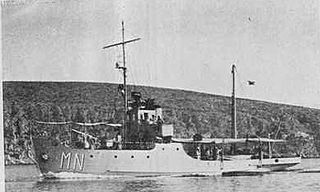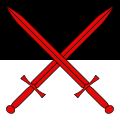
The ensign is a maritime flag that is used for the national identification of a ship. The ensign is the largest flag, generally flown at the stern (rear) of the ship while in port. In ports, depending on the ship's origin, it is sometimes identical with a jack on the bow of the ship. Jacks are more common on warships than on merchant ships.

The hammer and sickle is a communist symbol representing proletarian solidarity between agricultural and industrial workers. It was first adopted during the Russian Revolution at the end of World War I, the hammer representing workers and the sickle representing the peasants.

The national flag of Croatia or The Tricolour is one of the state symbols of Croatia. It consists of three equal size, horizontal stripes in colours red, white and blue. In the middle is the coat of arms of Croatia.

A red star, five-pointed and filled, is a symbol that has often historically been associated with communist ideology, particularly in combination with the hammer and sickle, but is also used as a purely socialist symbol in the 21st century. It has been widely used in flags, state emblems, monuments, ornaments, and logos.

A war flag, also known as a military flag, battle flag, or standard, is a variant of a national flag for use by a country's military forces when on land. The nautical equivalent is a naval ensign. Under the strictest sense of the term, few countries today currently have distinct war flags, most using a flag design that is also the state flag or general national flag for this purpose.

The Croatian Navy is a branch of the Croatian Armed Forces. It was formed in 1991 from what Croatian forces managed to capture from the Yugoslav Navy during the breakup of Yugoslavia and Croatian War of Independence. In addition to mobile coastal missile launchers, today it operates 30 vessels, divided into the Navy Flotilla for traditional naval duties, and the Croatian Coast Guard. Five missile boats form the Croatian fleet's main offensive capability.
A civil ensign is an ensign used by civilian vessels to denote their nationality. It can be the same or different from the state ensign and the naval ensign. It is also known as the merchant ensign or merchant flag. Some countries have special civil ensigns for yachts, and even for specific yacht clubs, known as yacht ensigns.

As of 3 June 2024, there are 193 member states in the United Nations (UN), each of which is a member of the United Nations General Assembly.
The presidential standard or presidential flag is the flag that is used in many countries as a symbol of the head of state or president. In some countries it may be for exclusive use of the president or only raised where the president is present. An equivalent in a monarchy is a royal standard, and in an empire, an imperial standard.
A field force in British and Indian Army military parlance is a combined arms land force operating under actual or assumed combat circumstances, usually for the length of a specific military campaign. It is used by other nations, but can have a different meaning.

Military aircraft insignia are insignia applied to military aircraft to visually identify the nation or branch of military service to which the aircraft belong. Many insignia are in the form of a circular roundel or modified roundel; other shapes such as stars, crosses, squares, or triangles are also used. Insignia are often displayed on the sides of the fuselage, the upper and lower surfaces of the wings, as well as on the fin or rudder of an aircraft, although considerable variation can be found amongst different air arms and within specific air arms over time.

The Albona class were mine warfare ships used by the Italian Regia Marina and Royal Yugoslav Navy. Fourteen ships were originally laid down between 1917 and 1918 for the Austro-Hungarian Navy as the MT.130 class. However, the end of World War I and the dissolution of Austria-Hungary left them incomplete until 1920, when three ships were finished for the Regia Marina. These ships were armed with two 76 mm (3 in) guns. An additional five ships were completed for the KM in 1931 as the Malinska or Marjan class, and were armed with a single 66 mm (2.6 in). All of the completed ships could carry 24 to 39 naval mines. The remaining ships were never completed.

Poland–Yugoslavia relations were historical foreign relations between Poland and now broken up Yugoslavia.

































































































































































































































































































